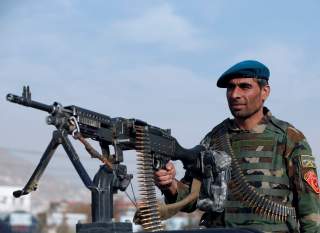America's Exit Strategy for Afghanistan is Flawed
It is time for America to end a militarized process that had its inception with the reaction to the Soviet invasion of Afghanistan decades ago.
America’s educational approach could include support for preserving cultural heritage, for that of Pakistan actually reflects roots of tolerance in the past, compared with the imported version of Islam ascendent since the Soviet invasion. In the right circumstances, Pakistan’s madrassas could turn back from Gulf supported Wahhabism to their historic orientation toward the more moderate madrassas of India. After all, mullahs have financial concerns too, especially when the money pool is drying.
Still, the real “carrot” in the peacemaking process is the postwar aid plan, which the Unitede States controls. In the rural areas, America’s initial priority should be on physical infrastructure. In particular, the area is ripe for road construction to benefit the rural inhabitants, where even today donkey transport competes with overloaded motorbikes for passage on narrow dirt paths. Political/military control as well as commerce would benefit. Since the Pakistan Army or its foundations control much of the limited frontier road construction, increased funding for such projects provides the incentive of commercially reasonable profit from peace. Equally, that approach can exploit selective subcontracting, which is consistent with existing Army practice in the frontier. But it would require equitable opportunity to share in the benefits. Permitting more local concerns to profit while fueling substantial employment is a politically necessary condition for the contract awards process. This time the administration of aid must be effected through civilian authorities to enhance accountability and promote democracy by not compromising institutional governance.
Priorities for the population would include schools, housing and staffed health clinics — not just temporary facilities. Ample permanent construction projects would offer tangible social service results from peace. It also provides employment opportunity to replace militancy based compensation. During the transition period guarding still could be funded and, where necessary, “transit rights” payments made too. However, the market compensation for construction jobs should be higher to promote the societal status of those earning through peaceful occupations.
Another necessary component is enhanced administration of speedy and equitable justice. Historically, in rural areas local khans resolved problems quickly, or the people turned to a “jirga” of village elders. Both approaches remain rooted in the local culture, despite occasional abuses and Taliban efforts to eliminate those who would not apply their version of Islamic justice. Going forward there should still be room for traditional community-based dispute resolution practices to continue, but without the existing veto power of the Political Agents for the FATA. The end to legacy Frontier Crimes Regulations and “collective responsibility” under them is necessary. Relinquishment of such powers can be protectively insulated by early extension of a modernized civil juridical system to FATA, like that which is now being implemented in the Peshawar High Court. These steps would signal the necessary rapidity of political consolidation. The speedy and fair administration of justice would eliminate a vulnerability the Taliban long exploited along the frontier.
A concomitant part of the process could be American brokered reciprocal restraint of present artillery and other armed exchanges between Pakistan and India in Kashmir. If a ceasefire holds, the next confidence building measure would trade Indian covert actions in Baluchistan in return for Pakistan’s in Bangladesh, which allegedly seek to drive Muslim immigrants into India to upset the political balance in Assam province. The success of “conscious parallelism” through self-restraint would promote detente, as in the Cold War. Specific American aid could be contingent upon and promote the integrity of these informal processes.
U.S. interests are ultimately served by accelerating communication of what peace will bring to South Asia. The new approach would come at ebb tide in the funding flow to our opponents, helping to blunt Russian arms support. The human and economic cost will be lower than that of conflict. Aid can be structured to transition society from an arms-bearing living to one of trade and commerce, with tangible benefit to the Af-Pak Pukthun population. The United States can avoid the political mistake made in the Soviet/Afghan war of receiving no political credit, for sufficient pacification in the frontier permits “branding” efforts as U.S. sponsored—without necessarily placing a target on projects as before. Last, but not least, distraction from rising threats will diminish, enhancing our ability to devote freed assets to confront them; we would no longer be “stuck on the fly paper.”
Reduced to essentials, simplifying America’s goal and military exit strategy in Af-Pak, coupled with communicating the rewards that could accompany it in return for meeting America’s core security need, creates a potential path to peace that has been unknown in the region for two generations. It is time for America to end a militarized process that had its inception with the reaction to the Soviet invasion of Afghanistan decades ago. America is still cleaning up the legacy of the Cold War; it has both the responsibility and capacity to do so. All America really need is the political will to give peace a chance.
Philip D. O’Neill Jr. is an international arbitrator and educator. He taught national-security law at Boston University Law School for many years, and international arbitration at Harvard and Boston College Law Schools. His books National Security and the Legal Process and Verification in An Age of Insecurity were published by Oxford University Press.

